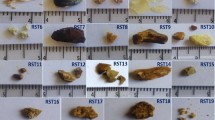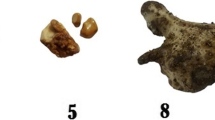Abstract
Thermal analysis and infrared (IR) spectroscopy are modern physical–chemical methods suitable for the investigation of the kidney stones composition. The applications of these methods in our work were anticipated by performing the standard thermal analysis and standard infrared spectra on pure compounds: oxalates, phosphate, carbonate, and uric acid. This work reveals a logical algorithm for correlating the experimental data regarding urolithiasis types and compositions by thermal analysis methods, Fourier Transform Infrared (FT-IR) spectroscopy, and second derivative FT-IR spectra. The limits and performance of each analysis method have been highlighted, and by correlating the results of both methods we have obtained comprehensive information for the identification and/or determination of the main components as well as of organic and/or inert impurities in calculi composition. The data regarding the urinary calculi composition are important for the clinical guideline in the prophilaxy and methaphylaxy of urolithiasis.











Similar content being viewed by others
References
Kohutova A, Hancova P, Podzemna V, Bezdicka P, Vecernikova E, Louda M, Seidel J. Thermal analysis of kidney stones and their characterization. J Therm Anal Calorim. 2010;101:695–9.
Daudon M, Bader CA, Jungers P. Urinary calculi: review of classification methods and classification with ethiology. Scann Micr. 1993;7(3):06–1081.
Cytron SE, Kravchick S, Sela B, Shulzinger E, Vasserman I, Raichlin Y, Katzir A. Fiberoptic infrared spectroscopy: A novel tool for the analysis of urine and urinary salts in situ and in real time. Urology 2003;61:231–5.
Sai Sathish R, Ranjit B, Ganesh KM, Nageswara RG, Janardhana C. A quantitative study on the chemical composition of renal stones and their flouride content from Anantapur District. Curr Sci. 2008;94(1):104–9.
Webb DR, Fitzpatrick JM. Experimental urolithotripsy. World J Urol. 1985;3(1):33–5.
Mahomed Ali A, Arunay Nambi Raj N, Kalainathan S, Palanichamy P. Microhardness and acoustic behavior of calcium oxalate monohydrate urinary stone. Mater Lett. 2008;62:2351–54.
Bhatt PA, Paul P. Analysis of urinary stone constituents using powder X-ray diffraction and FT-IR. J Chem Sci. 2008;120:267–73.
Abdel Goad EH, Bereckzy ZB. Metabolic risk factors in patiens with renal stones in KwaZulu Natal: an inter-racial study (Asian and Withes). Br J Urol Int. 2004;93:120–23.
Marickar YMF, Salim A. Clinical risk index in urolithiasis. Urol Res. 2009;37:283–7.
Costa Bauza A, Isern B, Perello J, Sanchis P, Grases F. Factors affecting the regrowth of renal stones in vitro: A contribution to the understanding of renal stone development. Scan J Urol and Nephr. 2005;39:194–99.
Daudon M, Donsimoni R, Hennequin C, Fellahi S, Le Moel G, Paris M, Troupel S, Lacour B. Sex and age-related composition of 10617 calculi analyzed by infrared spectroscopy. Urol Res. 1995;23:319–26.
Daudon M, Dore JC, Jungers P, Lacour B. Change the stone composition according to age and gender of patients: multivariate epidemiological approach. Urol Res. 2004;32:241–7.
Danvirutai C, Noisong P, Srithanrattana T. The kinetic and thermodynamic study of KNiPO4H2O from DSC and TG data. J Therm Anal Calorim. 2012;110:249–56.
Sperrin R, Rogers K, Lane D, Southerden P. An investigation into architecture and composition of urinary calculus. J Mater Sci Mater Med. 2007;13:7–9.
Siener JR, Hesse A. Fluid intake and epidemiology of urolithiasis. Eur J Clin Nutr. 2003;57:S47–51.
Campanella L, Cardarelli E, Curini R, D’Ascenzo G, Tomassetti M. Thermogravimetric analyisis of human renal calculi sampled in nineteenth century. J Therm Anal. 1992;38:2707–17.
Daudon M, Valognes A. Hennequin, Jungers P. Importances de l’analyse morpho-constitutionnelle des calculs et des cristaux urinaires pour le diagnostic étiologique et le suivi thérapeutique de la maladie lithiasique. Spectra Biol. 1992;92:33–51.
Abboud IA. Mineralogy and chemistry of urinary stones: patients from North Jordan. Environ Geochem Health. 2008;30:445–63.
Stefanescu M, Tita D, Ciucanu I. Analysis of renal calculi by thermal derivatography. Ann West Univ Timisoara. 1995;4:85–90.
Jungers P, Daudon M, Le Duc A. Lithiase urinaire. Paris: Ed. Flammarion Médecine Sciences; 1989.
Stefanescu M, Tita D, Ciucanu I. Phosphatic renal calculi. Physico-chemical methods of investigation. Ann West Univ Timisoara. 1996;5:141–45.
Estepa L, Daudon M. Contribution of Fourier transform infrared Spectroscopy to the identification of urinary stones and kidney crystal deposits. Biospectroscopy. 1997;3:347–69.
Sabot JF, Bornet CE, Favre S, Sabot-Gueriaux S. The analysis of peculiar urinary (and other) calculi: an endless source of challenge. Clin Chim Acta. 1999;283(1–2):151–8.
Oussama A, Kzaiber F, Mernari B, Semmoud A, Daudon M. Analysis of calculi by infrared spectrometry in children from the Moroccanmid-Atlas region. Ann Urologie. 2000;34:384–90.
Nguyen Hong TD, Phat D, Plaza P, Daudon M, Nguyen QD. Identification of urinary calculi by Raman laser fiber optics spectroscopy. Clin Chem. 1992;38:292–97.
Nguyen QD, Daudon M. IR and Raman spectra of calculi. Paris: Elsevier; 1997.
Prien EL. Crystallographic analysis of urinary calculi. J Urol. 1963;89:917–24.
Konjiki T, Sudo T, Kohyama N. Mineralogical notes of apatite in urinary calculi. Calcif Tissue Int. 1980;30:101–7.
Kaloustian J, Pauli AM, Pieroni G, Portugal H. The use of thermal analysis in determination of some urianary calculi of calcium oxalate. J Therm Anal Calorim. 2002;70:959–73.
Fazil Marikar YM, Lekshmi PR, Varma L, Koshy P. EDAX versus FTIR in mixed stones. Urol Res. 2009;37:271–76.
Ghosh S, Basu S, Chakraborty S, Mukherjee AK. Structural and microstructural characterization of human kidney stones from eastern India using IR spectroscopy, scanning electron microscopy, thermal study and X-ray Rietveld analysis. J Appl Cryst. 2009;42:629–35.
Strates BS. Use of TG in the study of nephrolits. Experientia. 1966;22:574–5.
Liptay G, Berenyi M. Study of urinary calculi using a new analytic procedure. Z Klin Chem Clin Biochem. 1967;5(4):188–90.
Berenyi M, Liptay G, Babics A. Thermoanalitical studies of kidney calculi (II) Calcium and magnesium containing calculi. Z Urol Nephrol. 1968;61(4):209–16.
D’Ascenzo G, Curini R, De Angelis G, Carandelle E, Magri A, Miano L. Renal calculi analysis, Aplication of thermal analytical techniques. Thermochim Acta. 1983;62:149–69.
Materazzi S, Curini R, D’Ascenzo G, Magri A. TG-FTIR coupled analysis characterization of human renal calculi. Thermochim Acta. 1995;264:75–93.
Kaloustian J, El-Moselhy TF, Portugal H. Determination of calcium oxalate (mono- and dihydrate) in mixtures with magnesium ammonium phosphate or uric acid: the use of simultaneous thermal analysis in urinary calculi. Clin Chim Acta. 2003;334(1–2):117–29.
Frost RL, Weier ML. Thermal treatment of whewellite - a thermal analysis and Raman spectroscopic study. Thermochim Acta. 2004;409:79–85.
Stavitzky A, Golay MJE. Smoothing and differentiation of data by simplified least squares procedures. Anal Chem. 1964;36:1627–39.
Berenyi M, Liptay G. The use of thermal analysis in medical science with special reference to nephroliths. J Therm Anal. 1971;3:437–43.
Schnitzler E, Kobelnik M, Sotelo GFC, Bannach G, Ionashiro M. Thermoanalytical study of purine derivatives compounds. Ecl Quim. 2004;29(1):71–8.
Wilson EV, Bushiri MJ, Vaidyan VK. Analytical characterization, thermal and FTIR studies of urinary calculi. J Optoel Biomed Mater. 2010;2(2):85–90.
Popescu (Pintilie) GS, Ionescu I, Grecu R, Preda A. The use of infrared spectroscopy in the investigation of urolithiasis. Rev Rom Med Lab. 2010;18(4):67–77.
Hesse A, Gergeleit M, Schüller P. Analysis of urinary stones by computerized infrared spectroscopy. J Clin Chem Clin Biochem. 1989;27:639–42.
Author information
Authors and Affiliations
Corresponding author
Rights and permissions
About this article
Cite this article
Popescu, S., Stefanescu, M., Popovici, E. et al. Evaluation of the renal calculi compositions. J Therm Anal Calorim 114, 765–775 (2013). https://doi.org/10.1007/s10973-013-3033-3
Received:
Accepted:
Published:
Issue Date:
DOI: https://doi.org/10.1007/s10973-013-3033-3




